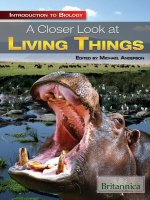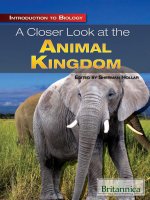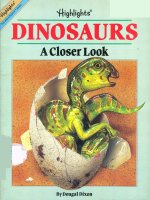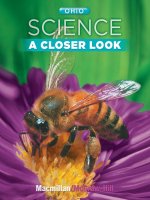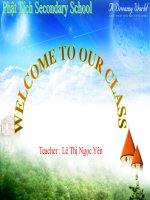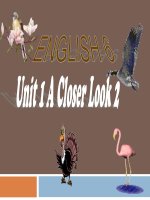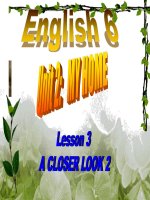Macmillan 08 SCIENCE a closer look g1
Bạn đang xem bản rút gọn của tài liệu. Xem và tải ngay bản đầy đủ của tài liệu tại đây (42.37 MB, 349 trang )
Program Authors
Dr. Dorothy J. T. Terman
Dr. Jay K. Hackett
Science Curriculum Development Consultant
Former K–12 Science and Mathematics Coordinator
Irvine Unified School District, CA
Irvine, CA
Professor Emeritus of Earth Sciences
University of Northern Colorado
Greeley, CO
Dr. Richard H. Moyer
Professor of Science Education and
Natural Sciences
University of Michigan–Dearborn
Dearborn, MI
Dr. JoAnne Vasquez
Elementary Science Education Consultant
NSTA Past President
Member, National Science Board
and NASA Education Board
Dr. Gerald F. Wheeler
Executive Director
National Science Teachers Association
Bank Street College of Education
New York, NY
Contributing Authors
Dr. Sally Ride
Sally Ride Science
San Diego, CA
Mulugheta Teferi, M.A.
Lucille Villegas Barrera, M.Ed.
Principal, Gateway Middle School
Center of Math, Science, and Technology
St. Louis Public Schools
St. Louis, MO
Elementary Science Supervisor
Houston Independent School District
Houston, TX
Dinah Zike, M.Ed.
Dinah Might Adventures LP
San Antonio, TX
Kathryn LeRoy, M.S.
Executive Director
Division of Mathematics and Science Education
Miami-Dade County Public Schools, FL
Miami, FL
American Museum
of Natural History
New York, NY
Contributing Writer
Ellen C. Grace, M.S.
Consultant
Albuquerque, NM
Students with print disabilities may be eligible to obtain an accessible, audio version of the pupil edition of this
textbook. Please call Recording for the Blind & Dyslexic at 1-800-221-4792 for complete information.
A
Copyright © 2008 by The McGraw-Hill Companies, Inc. All rights reserved.
Except as permitted under the United States Copyright Act, no part of this
publication may be reproduced or distributed in any form or by any means, or
stored in a database or retrieval system, without prior permission of the publisher.
Send all inquiries to:
Glencoe/McGraw-Hill
8787 Orion Place
Columbus, OH 43240-4027
ISBN: 978-0-02-287195-6
MHID: 0-02-287195-0
Printed in the United States of America.
1 2 3 4 5 6 7 8 9 10 (110/043) 11 10 09 08 07
ii
Content Consultants
Editorial Advisory Board
Paul R. Haberstroh, Ph.D.
Cathy Constance
Mary Ellen Murray
Mohave Community College
Lake Havasu City, AZ
Science Coordinator
Youngstown City Schools
Youngstown, OH
Science Curriculum Coordinator
Parma City Schools
Parma, OH
Kevin Cornell
Kevin Stinson
Teacher
Menlo Park Elementary
Huber Heights City Schools
Huber Heights, OH
Science Manager, K-12
Cincinnati City Schools
Cincinnati, OH
Carolyn Day
K-5 Science Curriculum Coordinator
Cleveland Municipal Schools
Cleveland, OH
Timothy Long
School of Earth and Atmospheric
Sciences
Georgia Institute of Technology
Atlanta, GA
Rick MacPherson, Ph.D.
Program Director
The Coral Reef Alliance
San Francisco, CA
Hector Córdova Mireles, Ph.D.
Physics Department
California State
Polytechnic University
Pomona, CA
Charlotte A. Otto, Ph.D.
Department of Natural Sciences
University of Michigan-Dearborn
Dearborn, MI
Paul Zitzewitz, Ph.D.
Department of Natural Sciences
University of Michigan-Dearborn
Dearborn, MI
Director of School Improvement
Past Science and Math Supervisor
Dayton Public Schools
Dayton, OH
Chris Doolittle
Science Resources
Westerville City Schools
Westerville, OH
Jim Hooper
Science Curriculum Leader
Vandalia-Butler City Scools
Vandalia, OH
James Lay
Teacher
Dayton Public Schools
Dayton, OH
Chris Moore-Goad
Math and Science Specialist
Kettering City Schools
Kettering, OH
Elizabeth Voit
Tracie Walsh
Teacher
Oakview Elementary
Kettering City Schools
Kettering, OH
Deb Wickerham
Teacher
Findlay City Schools
Findlay, OH
Jeff Winslow
Science Supervisor
Talawanda Schools
Oxford, OH
Missi Zender, Ph.D.
Science Resource Specialist
Summit County ESC
Cuyahoga Falls, OH
The American Museum of Natural History in New York City is one of the world’s preeminent scientific, educational, and
cultural institutions, with a global mission to explore and interpret human cultures and the natural world through scientific
research, education, and exhibitions. Each year the Museum welcomes around four million visitors, including 500,000
schoolchildren in organized field trips. It provides professional development activities for thousands of teachers; hundreds
of public programs that serve audiences ranging from preschoolers to seniors; and an array of learning and teaching resources for use in
homes, schools, and community-based settings. Visit www.amnh.org for online resources.
is a trademark of The McGraw-Hill Companies, Inc.
iii
Science Skills . . . . . . . . . . . . . . . . . . . . . . . . . . . .
Observe . . . . . . . . . . . . . . . . . . . . . . . . . . . . . . . . .
Compare . . . . . . . . . . . . . . . . . . . . . . . . . . . . . . . .
Classify . . . . . . . . . . . . . . . . . . . . . . . . . . . . . . . . .
Measure . . . . . . . . . . . . . . . . . . . . . . . . . . . . . . . . .
Put Things in Order. . . . . . . . . . . . . . . . . . . . . . . .
Record Data . . . . . . . . . . . . . . . . . . . . . . . . . . . . .
Make a Model . . . . . . . . . . . . . . . . . . . . . . . . . . . .
Communicate . . . . . . . . . . . . . . . . . . . . . . . . . . . .
Infer . . . . . . . . . . . . . . . . . . . . . . . . . . . . . . . . . . . .
Predict . . . . . . . . . . . . . . . . . . . . . . . . . . . . . . . . . .
Investigate . . . . . . . . . . . . . . . . . . . . . . . . . . . . . .
Draw Conclusions. . . . . . . . . . . . . . . . . . . . . . . . .
2
4
5
5
6
6
7
7
7
8
8
9
9
Scientific Method . . . . . . . . . . . . . . . . . . . . . . . 10
Observe . . . . . . . . . . . . . . . . . . . . . . . . . . . . . . . . . 12
Ask a Question . . . . . . . . . . . . . . . . . . . . . . . . . . . 12
Make a Prediction. . . . . . . . . . . . . . . . . . . . . . . . . 12
Make a Plan. . . . . . . . . . . . . . . . . . . . . . . . . . . . . . 13
Follow the Plan . . . . . . . . . . . . . . . . . . . . . . . . . . . 13
Record the Results . . . . . . . . . . . . . . . . . . . . . . . . 13
Try the Plan Again . . . . . . . . . . . . . . . . . . . . . . . . 14
Draw a Conclusion . . . . . . . . . . . . . . . . . . . . . . . . 14
The Design Process . . . . . . . . . . . . . . . . . . . . . . 16
Safety Tips . . . . . . . . . . . . . . . . . . . . . . . . . . . . . . 18
iv
v
BE A SCIENTIST
Ohio: A Closer Look . . . . . . . . . . . . . . . . . . . . . . . . . . . . . . . 20
East Fork State Park • Scioto Trail State Park
CHAPTER 1
Plants Are Living Things . . . . . . . . . . . . . . . . . . . . . . 24
Lesson 1
Learning About Living Things . . . . . . . . . . . . . 26
Reading in Science . . . . . . . . . . . . . . . . . . . . . . 32
Lesson 2 Parts of Plants . . . . . . . . . . . . . . . . . . . . . . . . . . 34
• Writing in Science • Math in Science . . . . . . 40
Lesson 3 Different Plants . . . . . . . . . . . . . . . . . . . . . . . . . 42
• Writing in Science • Math in Science . . . . . . 48
Lesson 4 Flowers, Fruits, and Seeds . . . . . . . . . . . . . . . . 50
• Focus on Skills: Classify . . . . . . . . . . . . . . . . . 56
I Read to Review My Plant Book. . . . . . . . . . . . . . . . . . . . . 58
Chapter Review . . . . . . . . . . . . . . . . . . . . . . . . . . . . . . . . . . 62
vi
CHAPTER 2
All About Animals . . . . . . . . . . . . . . . . . . . . . . . . . . . . 64
Lesson 1
All Kinds of Animals . . . . . . . . . . . . . . . . . . . . . 66
• Focus on Skills: Compare . . . . . . . . . . . . . . . . 74
Lesson 2 What Animals Need to Live . . . . . . . . . . . . . . . 76
• Writing in Science • Math in Science . . . . . . 82
Lesson 3 How Animals Eat Food . . . . . . . . . . . . . . . . . . . 84
• Be a Scientist . . . . . . . . . . . . . . . . . . . . . . . . . 90
I Read to Review My Animal Book . . . . . . . . . . . . . . . . . . . 92
Chapter Review . . . . . . . . . . . . . . . . . . . . . . . . . . . . . . . . . . 96
Unit Literature Giraffes . . . . . . . . . . . . . . . . . . . . . . . . . 98
Careers in Science . . . . . . . . . . . . . . . . . . . . . . . . . . . . . . . 100
vii
Ohio: A Closer Look . . . . . . . . . . . . . . . . . . . . . . . . . . . . . . 102
Holden Arboretum • Alum Creek State Park
CHAPTER 3
Looking At Earth . . . . . . . . . . . . . . . . . . . . . . . . . . . . . 106
Lesson 1
What Earth Looks Like . . . . . . . . . . . . . . . . . . 108
• Focus on Skills: Make A Model . . . . . . . . . . . 116
Lesson 2 Rocks and Soil . . . . . . . . . . . . . . . . . . . . . . . . . . 118
Reading in Science . . . . . . . . . . . . . . . . . . . . . 124
Lesson 3 Changing the Land . . . . . . . . . . . . . . . . . . . . . 126
• Writing in Science • Math in Science . . . . . 134
I Read to Review My Earth Book . . . . . . . . . . . . . . . . . . . 136
Chapter Review . . . . . . . . . . . . . . . . . . . . . . . . . . . . . . . . . 140
CHAPTER 4
Caring for Earth . . . . . . . . . . . . . . . . . . . . . . . . . . . . . . 142
Lesson 1
Earth’s Resources . . . . . . . . . . . . . . . . . . . . . . 144
• Focus on Skills: Investigate . . . . . . . . . . . . . 152
Lesson 2 Using Earth’s Resources . . . . . . . . . . . . . . . . . 154
Reading in Science . . . . . . . . . . . . . . . . . . . . . 160
Lesson 3 Saving Earth’s Resources . . . . . . . . . . . . . . . . 162
• Writing in Science • Math in Science . . . . . 168
I Read to Review My Resources Book. . . . . . . . . . . . . . . . 170
Chapter Review . . . . . . . . . . . . . . . . . . . . . . . . . . . . . . . . . 174
viii
CHAPTER 5
Seasons and Living Things. . . . . . . . . . . . . . . . . . . . 176
Lesson 1
Spring and Summer . . . . . . . . . . . . . . . . . . . . 178
Reading In Science . . . . . . . . . . . . . . . . . . . . . 184
Lesson 2 Fall and Winter . . . . . . . . . . . . . . . . . . . . . . . . 186
• Writing in Science • Math in Science . . . . . 192
I Read to Review My Seasons Book . . . . . . . . . . . . . . . . . 194
Chapter Review . . . . . . . . . . . . . . . . . . . . . . . . . . . . . . . . . 198
Unit Literature Weather and Animals . . . . . . . . . . . . . 200
Careers in Science . . . . . . . . . . . . . . . . . . . . . . . . . . . . . . . 202
ix
Ohio: A Closer Look . . . . . . . . . . . . . . . . . . . . . . . . . . . . . . 204
Dayton Air Show • Great Lakes Science Center
CHAPTER 6
Matter Everywhere. . . . . . . . . . . . . . . . . . . . . . . . . . 208
Lesson 1
Describing Matter . . . . . . . . . . . . . . . . . . . . . . 210
Reading in Science . . . . . . . . . . . . . . . . . . . . . 216
Lesson 2 Matter Can Change . . . . . . . . . . . . . . . . . . . . 218
• Focus on Skills: Measure . . . . . . . . . . . . . . . 222
Lesson 3 Making Mixtures . . . . . . . . . . . . . . . . . . . . . . . 224
• Writing in Science • Math in Science . . . . . 230
Lesson 4 Heat Can Change Matter . . . . . . . . . . . . . . . . 232
• Be a Scientist . . . . . . . . . . . . . . . . . . . . . . . . 238
I Read to Review My Mixtures Book. . . . . . . . . . . . . . . . . 240
Chapter Review . . . . . . . . . . . . . . . . . . . . . . . . . . . . . . . . . 244
x
CHAPTER 7
Motion and Energy . . . . . . . . . . . . . . . . . . . . . . . . . . 246
Lesson 1
Position and Motion . . . . . . . . . . . . . . . . . . . . 249
• Focus on Skills: Infer . . . . . . . . . . . . . . . . . . 254
Lesson 2 Pushes and Pulls . . . . . . . . . . . . . . . . . . . . . . . 256
• Be a Scientist . . . . . . . . . . . . . . . . . . . . . . . . 262
Lesson 3 Magnets. . . . . . . . . . . . . . . . . . . . . . . . . . . . . . 264
• Writing in Science • Math in Science . . . . . 270
Lesson 4 Energy and Heat . . . . . . . . . . . . . . . . . . . . . . . 272
• Focus on Skills: Draw Conclusions . . . . . . . . 278
Lesson 5 Electricity . . . . . . . . . . . . . . . . . . . . . . . . . . . . . 280
• Writing in Science • Math in Science . . . . . 284
I Read to Review My Motion Book . . . . . . . . . . . . . . . . . . 286
Chapter Review . . . . . . . . . . . . . . . . . . . . . . . . . . . . . . . . . 290
Unit Literature For A Quick Exit. . . . . . . . . . . . . . . . . . 292
Careers in Science . . . . . . . . . . . . . . . . . . . . . . . . . . . . . . . 294
xi
Life Sciences
CHAPTER 1
CHAPTER 2
Explore Activities
Explore Activities
What is living and nonliving? . . . .27
What are some different kinds
of animals? . . . . . . . . . . . . . . . . . . .67
What are the parts of a plant? . . .35
How are plants different? . . . . . . .43
How can you classify seeds? . . . . . 51
How do animals get what they
need to live? . . . . . . . . . . . . . . . . . .77
Quick Labs
How do teeth help you eat
different foods? . . . . . . . . . . . . . . .85
Living and Nonliving Things . . . . .29
Quick Labs
How Stems Work . . . . . . . . . . . . . .38
Animal Guessing Game . . . . . . . . . 71
Plant Parts We Eat . . . . . . . . . . . . .46
Comparing Animal Parts . . . . . . . . 81
Inside a Lima Bean . . . . . . . . . . . . .54
What First Graders Like to Eat . . . .89
xii
Be a Scientist investigations and Focus on Skills
skill builders are found in the Activities Flipchart.
Earth and Space Sciences
CHAPTER 3
CHAPTER 5
Explore Activities
Explore Activities
What can an island look like? . . . 109
Do seeds grow faster when
it is warm or cold? . . . . . . . . . . . . 179
How can you classify rocks? . . . . . 119
How can water break rock? . . . . 127
Quick Labs
Water Near You . . . . . . . . . . . . . . . 112
Hard and Soft Rocks. . . . . . . . . . . . 121
How do sweaters keep
us warm?. . . . . . . . . . . . . . . . . . . . 187
Quick Labs
Clothes for All Seasons . . . . . . . . . 181
Leaves in Different Seasons . . . . . 189
Sand Erosion . . . . . . . . . . . . . . . . . 133
CHAPTER 4
Explore Activities
What things are made
from plants or animals? . . . . . . . . 145
When do you use water
every day? . . . . . . . . . . . . . . . . . . . 155
What happens to plastic
when you throw it away? . . . . . . 163
Quick Labs
Soil as a Home for Animals . . . . . 150
Blowing in the Wind . . . . . . . . . . 158
Use It Again . . . . . . . . . . . . . . . . . 165
xiii
Physical Sciences
CHAPTER 6
CHAPTER 7
Explore Activities
Explore Activities
How can you compare
objects? . . . . . . . . . . . . . . . . . . . . . . 211
How do you know
something moved? . . . . . . . . . . . 249
How can you change
some solids? . . . . . . . . . . . . . . . . . 219
How can you make
something move? . . . . . . . . . . . . . 257
Can you take a mixture apart? . . 225
What will a magnet pull? . . . . . . 265
How can heat change ice? . . . . . 233
How can heat change things?. . . 273
Quick Labs
What do some things need
to work? . . . . . . . . . . . . . . . . . . . . 281
Describing Classroom Objects . . . 213
Paper in the Sun . . . . . . . . . . . . . . 221
Quick Labs
Objects That Float or Sink . . . . . . 227
Changing the Way
a Ball Moves . . . . . . . . . . . . . . . . . 252
Mass of Water and Ice. . . . . . . . . 235
Sliding a Checker Piece . . . . . . . . 260
A Magnet’s Strength . . . . . . . . . . 268
Using the Sun’s Energy . . . . . . . . 275
Using Electricity in School . . . . . . 283
xiv
Some turtles can live
to be 100 years old!
SI-A. Ask a testable question. SI-B. Design and conduct a simple investigation
to explore a question. SI-C. Gather and communicate information from careful
observations and simple investigation through a variety of methods.
Have you ever wondered about
animals? Scientists wonder about
things in our world, too.
2
SCIENCE SKILLS
SWK-2. Demonstrate good explanations based on evidence from
investigations and observations.
What do you notice about
these animals?
What to Do
Look at the animals
on this page.
How are the animals
alike? How are they
different?
Put the animals into
groups. Tell a classmate
why you put the animals
in each group.
Explore More
Think of other animals
that you could add
to your groups.
SI-8. Use oral, written and pictorial representation to communicate work.
3
SCIENCE SKILLS
What do scientists do?
You observed animals to see what
they were like. Scientists observe
things, too. You can be a scientist!
When you observe something, you
carefully look, hear, taste, touch,
or smell it.
Observe What can you observe
about these animals?
4
SCIENCE SKILLS
dog
fish
bird
butterfly
Scientists can compare and classify
animals to learn more about them.
Compare means to see how things
are alike or different. Classify
means to group things by how
they are alike.
Compare and Classify
Sort these animals into groups.
koala
flamingo
ladybug
snake
5
SCIENCE SKILLS
How do scientists work?
Scientists also measure things.
Measure means to find out the
size or amount of something.
Measuring can help scientists
put things in order, or tell
which comes first, next, and last.
Measure Use a ruler to
measure these insects.
butterfly
bee
fly
beetle
dragonfly
6
SCIENCE SKILLS
Scientists can make a chart to
record data, or write down what
they observe. They can also
make a model to show how
something looks or works.
Make a Model
When you write or tell your
ideas to others you communicate
what you have learned.
Communicate
What does this
chart tell you
about insects?
cent
ime
ters
7
SCIENCE SKILLS
How do scientists learn
new things?
Scientists infer, or use what they
know to figure something out.
Scientists also predict, or use
what they know to tell what
they think will happen.
Infer
It is winter. You can
infer that there is not
a lot of food for the
bird to eat.
8
SCIENCE SKILLS
Predict
The bird is hungry.
You can predict that
it will eat the food
in the feeder.
Then scientists investigate by
making a plan and following it.
They can draw conclusions, or
use what they observe
to explain what happens.
Investigate
To investigate, you
can try to feed the
bird different seeds.
Draw Conclusions
If there are no sunflower
seeds left, you can draw
the conclusion that the
bird liked them best.
1. Describe what scientists do to learn
more about our world.
2. Write a list of things that you want
to know more about.
9
SCIENCE SKILLS
Have you ever wondered about
snails? What could you do to find
out about them?
10
SCIENTIFIC METHOD
SWK-1. Discover that when a science investigation is done the same
way multiple times, one can expect to get very similar results each
time it is performed.
